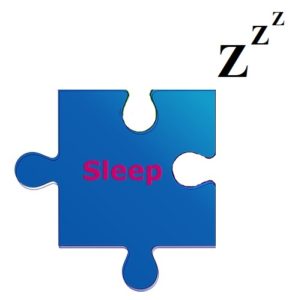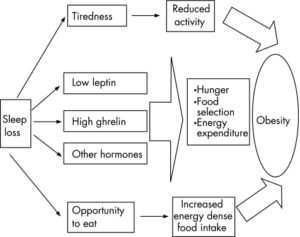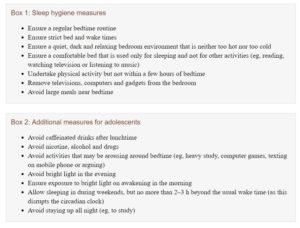
Getting enough quality sleep is one of the four pieces I think are needed in order to complete the ‘health jigsaw‘ – maybe a bit corny in terms of symbolism, but research suggests it’s pretty serious stuff when it comes to diseases that may arise from Z’s. This subject was covered in some detail in a previous blog 1 , but it’s worth revisiting because of its importance for our health.
We’ll quickly look at some significant research relating to four potential side-effects that may result if we don’t get enough sleep:
- depression
- type 2 diabetes
- obesity
- cardiovascular disease
Blog Contents
1. Depression
There’s a fair amount of research into the relationship between sleep and depression. However, we’ll just focus on an interesting December 2017 study 2 which looked at the relationship between sleep and depression in those people who care for individuals with advanced dementia – a pretty stressful role at the best of times.
Study method
Levels of depression and quantity/quality of sleep were measured in 57 dementia caregivers, with an average age of 74 years.
Study results
They found that the severity of depression symptoms were associated with a greater fragmentation of sleep and less sustained resting periods.
Comments
This is just one of the many studies looking at the relationship between depression and sleep within a wide range of population groups, including young doctors, adolescent students, HIV sufferers, etc. The take-home message from all these studies appears to be the same: insufficient quality sleep is strongly associated with increased symptoms of depression.
2. Type 2 diabetes
A September 2006 study 3 looked at whether insufficient sleep is linked to increased risk of developing type 2 diabetes – specifically whether short or poor sleep is associated with glycaemic control 4 in African Americans with type 2 diabetes mellitus.
Study background
Previous evidence suggests that decreased sleep duration or quality may increase diabetes risk.
Study method
161 participants’ haemoglobin A1c (HbA1c) levels 5 were obtained from medical charts and compared with an assessment of their sleep quality.
Study results
A relationship was indeed found between increased HbA1c levels and decreased sleep (described as ‘sleep debt’).
Comment
This and certain other studies suggest that the duration and quality of sleep are predictors of levels of HbA1c, and optimising sleep duration and quality may be important means of improving blood sugar control in persons with type 2 diabetes. Further research is needed to establish the contribution that chronic sleep debt may play in the initial development of diabetes.
3. Obesity
A November 2006 study 6 looked at the relationship between the development of obesity and short sleep duration.
Study method
A review was made of the existing (large) body of studies that support the hypothesis that obesity is strongly associated with reduced sleep duration and quality.
Study results
The following chart suggests the mechanisms involved:

Associations have been consistently shown between short sleep duration and excess body weight. This association exists across all age groups, but it has been particularly pronounced in children. It’s thought that sleep in childhood and adolescence is particularly important for brain development – specifically how it can adversely affect the function of a region of the brain known as the hypothalamus, which regulates appetite and the energy expenditure.
Study recommendations
The following charts from the study are suggestions on how to improve sleep duration and quality:

4. Cardiovascular Disease
We’ve already looked 7 at how obstructive sleep apnea (OSA) 8 affects the gut microbiota, but a January 2006 study 9 looked specifically at the increasing evidence that OSA may have a causal relationship with the development of hypertension.
Study background
It’s already established that OSA may be implicated in stroke and transient ischaemic attacks. OSA is also associated with coronary heart disease, heart failure, and cardiac arrhythmias.
Study method
This study focused on a review of evidence for factors which link cardiovascular disease and OSA.
Study results
There is is evidence that OSA is associated with a group of proinflammatory and prothrombotic factors that have been identified as important in the development of atherosclerosis, including:
- increased daytime and nocturnal sympathetic activity 10
- autonomic abnormalities 11 , including
- increased resting heart rate
- decreased R-R interval variability 12
- increased blood pressure variability
Atherosclerosis and OSA are each associated with the following:
- endothelial dysfunction
- increased C-reactive protein
- increased interleukin 6
- increased fibrinogen
- increased plasminogen activator inhibitor
- reduced fibrinolytic activity
- leukocyte adhesion and accumulation on endothelial cells
OSA has also been associated with enhanced platelet activity and aggregation.
Study conclusion
“Clinicians should be aware that OSA may be a risk factor for the development of cardiovascular disease.”
Comment
It appears that OSA is a likely predictor of the development of cardiovascular disease.
Final thoughts
The foregoing is just a brief overview of a selected number of negative effects associated with reduced sleep duration and quality. So, if you want to do the best for your body and mind, it makes sense to prioritise bedtime and do all you can to enhance sleep time. Eating an optimally healthy diet, reducing stress and getting lots of exercise will help us to sleep better and, together, these four elements can then combine to provide us with a ‘picture’ of health.

References
- The Importance of Sleep [↩]
- Rest-activity rhythm and sleep characteristics associated with depression symptom severity in strained dementia caregivers. Smagula SF, Krafty RT, Taylor BJ, Martire LM, Schulz R, Hall MH. J Sleep Res. 2017 Dec;26(6):718-725. doi: 10.1111/jsr.12549. Epub 2017 May 10. PMID: 28488270. [↩]
- Knutson KL, Ryden AM, Mander VA, Van Cauter E. Role of sleep duration and quality in the risk and severity of type 2 diabetes mellitus. Arch Intern Med 2006;166:1768–1764. [↩]
- Glycaemic control is the aim to regulate and maintain blood glucose levels within normal ranges. Long-term glycaemic control reduces later incidence of secondary diabetic complications. [↩]
- Haemoglobin A1c, often abbreviated to HbA1c, is a form of haemoglobin (a blood pigment that carries oxygen) bound to glucose. The blood test for HbA1c level is routinely performed in people with type 1 and type 2 diabetes mellitus. Blood HbA1c levels are reflective of how well diabetes is controlled is primarily to identify the three-month average plasma glucose concentration. [↩]
- Taheri S. The link between short sleep duration and obesity: We should recommend more sleep to prevent obesity. Arch Dis Child 2006;91:881–884. [↩]
- Obstructive Sleep Apnea (OSA) & Gut Microbiota [↩]
- It causes breathing to repeatedly stop and start during sleep. There are several types of sleep apnea, but the most common is obstructive sleep apnea. This type of apnea occurs when your throat muscles intermittently relax and block your airway during sleep. A noticeable sign of obstructive sleep apnea is snoring. [↩]
- Kasasbeh E, Chi DS, Krishnaswamy G. Inflammatory aspects of sleep apnea and their cardiovascular consequences. South Med J 2006;99:58–67. [↩]
- The sympathetic nervous system activates what is often termed the fight or flight response. [↩]
- Autonomic abnormalities or nerve Disorders: The autonomic nervous system controls much of your involuntary functions. Symptoms are wide-ranging and can include problems with the regulation of heart rate, blood pressure, body temperature, perspiration, and bowel and bladder functions. [↩]
- Heart rate variability (HRV) is the variation of beat to beat intervals, also known as R-R intervals. Electrocardiogram (ECG) is the electric signal originating from heart. … Variation of beat to beat intervals, also known as R-R intervals. [↩]